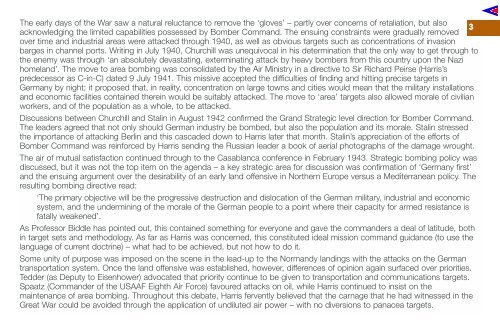Volume 4 No 4 - Air Power Studies
Volume 4 No 4 - Air Power Studies
Volume 4 No 4 - Air Power Studies
You also want an ePaper? Increase the reach of your titles
YUMPU automatically turns print PDFs into web optimized ePapers that Google loves.
The early days of the War saw a natural reluctance to remove the ‘gloves’ – partly over concerns of retaliation, but also<br />
3<br />
acknowledging the limited capabilities possessed by Bomber Command. The ensuing constraints were gradually removed<br />
over time and industrial areas were attacked through 1940, as well as obvious targets such as concentrations of invasion<br />
barges in channel ports. Writing in July 1940, Churchill was unequivocal in his determination that the only way to get through to<br />
the enemy was through ‘an absolutely devastating, exterminating attack by heavy bombers from this country upon the Nazi<br />
homeland’. The move to area bombing was consolidated by the <strong>Air</strong> Ministry in a directive to Sir Richard Peirse (Harris’s<br />
predecessor as C-in-C) dated 9 July 1941. This missive accepted the difficulties of finding and hitting precise targets in<br />
Germany by night; it proposed that, in reality, concentration on large towns and cities would mean that the military installations<br />
and economic facilities contained therein would be suitably attacked. The move to ‘area’ targets also allowed morale of civilian<br />
workers, and of the population as a whole, to be attacked.<br />
Discussions between Churchill and Stalin in August 1942 confirmed the Grand Strategic level direction for Bomber Command.<br />
The leaders agreed that not only should German industry be bombed, but also the population and its morale. Stalin stressed<br />
the importance of attacking Berlin and this cascaded down to Harris later that month. Stalin’s appreciation of the efforts of<br />
Bomber Command was reinforced by Harris sending the Russian leader a book of aerial photographs of the damage wrought.<br />
The air of mutual satisfaction continued through to the Casablanca conference in February 1943. Strategic bombing policy was<br />
discussed, but it was not the top item on the agenda – a key strategic area for discussion was confirmation of ‘Germany first’<br />
and the ensuing argument over the desirability of an early land offensive in <strong>No</strong>rthern Europe versus a Mediterranean policy. The<br />
resulting bombing directive read:<br />
‘The primary objective will be the progressive destruction and dislocation of the German military, industrial and economic<br />
system, and the undermining of the morale of the German people to a point where their capacity for armed resistance is<br />
fatally weakened’.<br />
As Professor Biddle has pointed out, this contained something for everyone and gave the commanders a deal of latitude, both<br />
in target sets and methodology. As far as Harris was concerned, this constituted ideal mission command guidance (to use the<br />
language of current doctrine) – what had to be achieved, but not how to do it.<br />
Some unity of purpose was imposed on the scene in the lead-up to the <strong>No</strong>rmandy landings with the attacks on the German<br />
transportation system. Once the land offensive was established, however, differences of opinion again surfaced over priorities.<br />
Tedder (as Deputy to Eisenhower) advocated that priority continue to be given to transportation and communications targets.<br />
Spaatz (Commander of the USAAF Eighth <strong>Air</strong> Force) favoured attacks on oil, while Harris continued to insist on the<br />
maintenance of area bombing. Throughout this debate, Harris fervently believed that the carnage that he had witnessed in the<br />
Great War could be avoided through the application of undiluted air power – with no diversions to panacea targets.
















